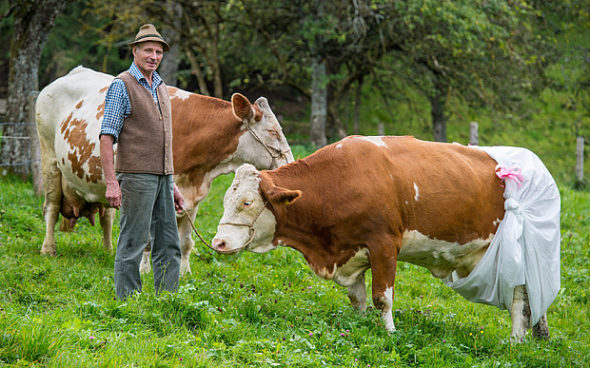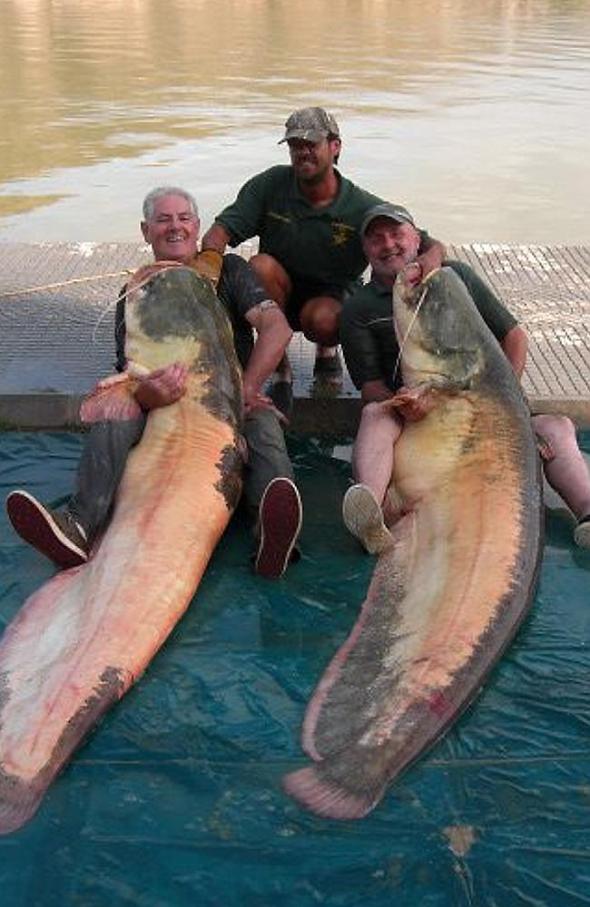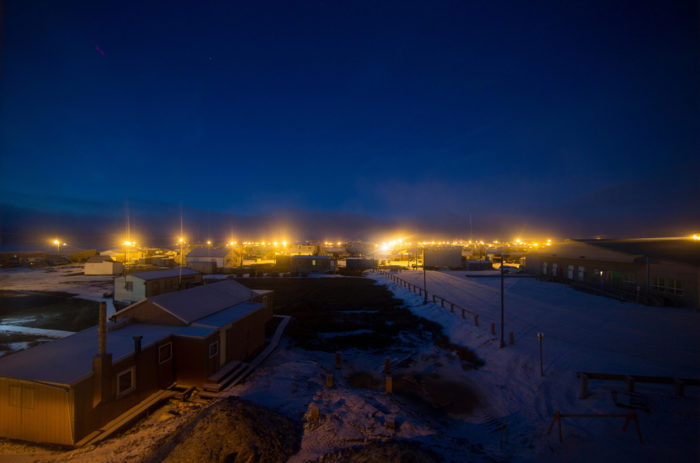
Farmer Johann Huber presents his cows Ami (left) and Doris, in a diaper, in Gmund am Tegnersee, Germany
Bavarian farmer puts nappies on his cows in EU protest
Farmers in the German state of Bavaria are angry that their famous Alpine dairy cows will apparently have to wear nappies [diapers] under European Union environmental laws.
Johann Huber, whose family has farmed on the mountain slopes of Gmund am Tegernsee for over 400 years, has begun putting home made nappies on his 18 diary cows to avoid falling foul of an EU fertiliser ban.
Mr Huber said that his cow Doris had behaved well when he fitted her with a home made bovine nappy to prevent her dropping cow pats on the Alpine slopes.
“We have no standard nappies, they have not been developed commercially yet,” he said.
The Bavarian farm union is protesting against the EU nitrates directive that they say has led to a ban on fertilizers, or the manure left behind by their cows, on any mountain slope with a gradient of more than 15 per cent.
“We demand that the ban is stopped in Germany,” said Anton Kreitmair, the association’s president in Upper Bavaria. “In Bavaria no fertilization would be possible on half the cultivated land and restrictions would be needed on cows grazing in Alpine pastures.”
Farmers in breach of the EU nitrates directive face losing their European agricultural subsidies, a penalty that would drive Bavaria’s mountain farmers out of business.
The European Commission has denied the EU responsibility and pointed to how Germany has implemented the legislation.
The commission has begun legal action against Germany for failing to enforce the EU directive which restricts “land application of fertilizers to steeply sloping ground, to avoid leaching of nitrates and water pollution.”
“The nitrates directive does not foresee a ban on grazing animals on sloping land,” said a spokesman. “Germany is revising its national nitrates action program. However, it is not likely that the German authorities will propose any ban on grazing animals on sloping land.”
A Brussels source added: “Bavarian farmers should raise this issue with the German Federal authorities in Berlin, rather than with the Commission in Brussels.”
The 23 year old EU legislation has proved difficult to enact across Europe and Germany has been forced to introduce new regulations after the commission threatened to fine Berlin earlier this summer.
Huge catfish caught by British man
British retirees Tom Herron and John Edwards were fishing in Spain, in a region known for producing sizable catfish. But they couldn’t have foreseen what their trip, on Sept. 23, would produce.
If Edwards, at left, is slightly disappointed with the way things turned out, that would only be because, less than two hours before Herron’s record catch, he had set the mark for the largest albino catfish ever caught, at 209 pounds. In a report by the Western (U.K.) Morning News, Herron had this to say:
“He was running up and down the bank shouting ‘yes, yes, I’ve caught the biggest fish’.
“But when they were photographing his catch my rod started to go, and I said ‘I’ve got a big fish here, I don’t know what it was – but it’s one big fish.’ ”

John Edwards (left) with his catfish and Tom Herron (right) with his record breaking catfish with their friend Ashley Scott. The two friends hooked the rare fish just minutes apart. Source: Snapper Media
Incidentally, these catfish are not technically albino; they are just called that because of their unusually light pigmentation. They are very rare, and reportedly can grow to up to 13 feet long.
Herron and Edwards were fishing for sport, so after photographing and weighing their prizes, they released the giant catfish back into the water.
From London’s Telegraph and The Washington Post.
Polish town to build statue honoring Wikipedia?
A Polish town is to build a monument to Wikipedia, the online encyclopedia designed to provide free information to anyone with a computer.
Costing £9,400, the tribute to the Internet website will be unveiled in a central square in Slubice, a town of 18,000 people near the German border.

The idea of the monument came from Krzysztof Wojciechowski, the director of a local college, who said he was on awe of the service Wikipedia provided and the website’s scale.
Since its launch in 2001, the website has proved to be a hit in Poland, with the Polish version now boasting over a million articles, making it the 12th biggest Wikipedia site.
The statue, less than two metres tall and made of a laminated material designed to look like brass, will consist of four figures holding up the Wikipedia symbol. Its designer is Mihran Hakobjan, a 30-year-old Armenian-born artist, who graduated from a Slubice college.
Piotr Luczynski, the town’s deputy mayor, said the statue could become a tourist attraction and also reflected the town’s ideals and aspirations.
“The monument — a tribute to an entire community working selflessly for the benefit of others — we found interesting and worthy of being in Slubice,” he said.
Mr Luczynski added the statue fitted in with the aspirations of the town which “despite being small wanted to be unique.”



